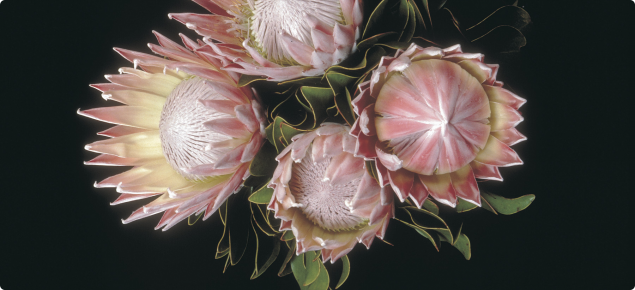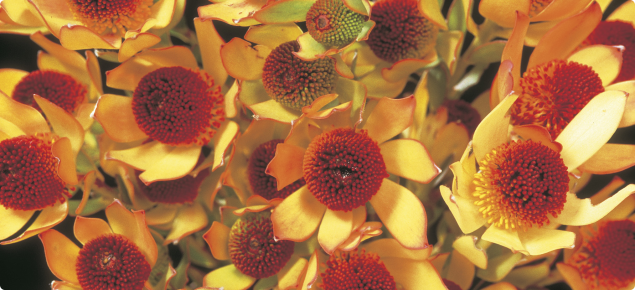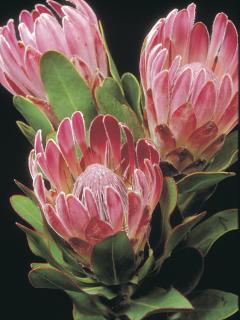Climate
Proteas prefer a mild Mediterranean climate with low humidity. They can tolerate slight frosts, but the young foliage and flowers of some species, such as P. nerifolia and P. cynaroides, may be slightly damaged.
Leucadendrons and leucospermums are generally unaffected by high summer temperatures. Flowering proteas can be damaged by persistent high temperatures, although adequate irrigation can reduce the damage.
Soils
Proteas prefer deep, well drained sand with pH 5.0 to 6.0 for optimum growth and production. Avoid alkaline soils for most species. Proteas prefer a low phosphorus (20 mg/kg soil) site. Test the soil before planting a new area to determine the residual phosphorus level.
Some land preparation is needed. Clear the area three to six months before planting, removing obvious timber and roots and any persistent weeds. Deep ripping, ploughing and cultivating to produce a good tilth are necessary for good plant growth. To minimise the risk of introducing or spreading Phytophthora species, ensure all soil is removed from machinery before use.
Species selection
Flowers and foliage are taken from over 10 Protea species, Leucospermum cordifolium and several Leucadendron species.
Leucadendrons are grown for their attractive foliage and fruiting heads, while proteas, serruria and leucospermums are grown for flowers The most important export species are listed in Table 1. Female forms of Leucadendron species are generally preferred.
| Species | Production period | Approximate yield (stems/mature plant) |
|---|---|---|
| Protea cynaroidesa
| March to January | 10–15 |
| Protea nerifoliaa
| January to September | 30-40 |
| Protea Pink Ice | March to August | 30-40 |
| Protea compacta | May to October | 30-40 |
| Protea repensa | February to July | 40-50 |
| Leucadendron daphnoides | May to July | 30-40 |
| Leucadendron discolorb | July to November | 40-50 |
| Leucadendron galpiniib | September to December | 40-50 |
| Leucadendron gandogeri | July to September | 40-50 |
| Leucadendron laureolumb | May to October | 30-40 |
| Leucadendron salicifoliumb | July to November | 50-70 |
| Leucadendron Silvan Red | December to June | 50-60 |
| Leucospermum cordifoliuma | September to November | 40-50 |
| Serruria florida | May to August | 15-20 |
| a Variants and selections can change flowering time | ||
| b May be harvested as green foliage earlier or later than indicated | ||
To assist in determining the range of species and number of plants to be grown, consult exporters, nurserymen and other experienced individuals or associations. Check out likely returns, market trends and expected demand.
Growing proteas is a long-term investment. The initial selection of species is critical, since substantial product will not be harvested until two or three years (leucadendrons) to three to four years (proteas and leucospermums) after planting. A range of species will minimise reliance on a single species.
Increasingly, named varieties of proteas are based on cuttings from ‘improved’ forms of selected species grown from seed. The only important protea still grown from seed is P. cynaroides.
Most plants are bought as rooted cuttings or seedlings from specialised nurseries.
Planting
Early to mid-autumn and spring plantings produce the best results, although plants may be established with care at any time of the year. The plants should be disease-free, 100 to 200mm high, with well formed roots. Ensure they are not pot-bound. Minimise root disturbance by removing plants carefully from pots.
Sand blasting and strong winds can damage young seedlings. Protect plants with artificial or living windbreaks.
The planting layout will depend on irrigation design and species selected. In general, use single rows 3.5 to 5m apart, with 1 to 3m between plants. Single rows make management easier, but some growers alternate their plants along double rows.
Double rows use smaller areas more effectively and give more plants per hectare than single rows.
Pruning
Pruning is essential for best plant growth and flower yield. Removing lower stems can make weed and disease control easier and timely pruning can influence flowering time.
On mature bushes, harvesting is the main pruning operation. Do any additional pruning or general cleaning up as close as possible to the beginning of the vegetative growth phase, which is usually soon after flowering.
Proteas will tolerate severe pruning, but generally only cut back to wood with green leaves. Severe pruning usually affects subsequent plant growth and flowering may be restricted for one to two years.
Use sharp secateurs. If disease is suspected, disinfect the secateurs regularly with a biocide such as sodium hypochlorite.
Some plants do not respond to pruning and remain twisted and misshapen. Remove them.
Successful shaping of the bush begins with careful pruning of the seedling. For convenience, each of the main genera can be divided into groups.
Proteas needing early tip pruning
Some Protea species need early tip pruning – P. nerifolia, P. repens, P. compacta, P. Pink Ice, P. longifolia, P. eximia and P. obtusifolia.
On these plants, remove the growing tip soon after planting to promote side shoot development. Tip prune side shoots when they reach 150 to 200mm.
Regularly tip prune in spring and late summer for the first two years. The plants should flower in the third year and additional pruning should be done after harvest.
Self-branching proteas
The self-branching species P. magnifica and P. grandiceps should be left alone unless only one stem grows. In this case, they should be tip pruned.
Proteas with lignotubers
Lignotuberous species such as P. cynaroides initially produce only one stem that flowers. After harvest, several side shoots will develop.
Some growers prefer to remove the main stem back to 200 to 250mm, six months after planting. This allows four to six stems to develop. These can be pruned 12 months after the first pruning and then hard-pruned back to the base after the flowers have been harvested.
Leucadendrons
Prune leucadendrons in the same way as proteas that need early tip pruning. Excess and poorly positioned stems may need to be removed.
Leucospermums
Prune leucospermums in the same way as proteas that need early tip pruning from an early stage to promote multiple branching. Depending on the selections and growth form, some leucospermums can produce sprawling, horizontal growth. Prune this back to allow new growth to develop from leaf nodes.
When harvesting, leave four or five leaf nodes at the base of strong flowering stems and cut back weak flowering or poorly positioned stems to the main stem.
Fertiliser
Young plants respond to moderate levels of nitrogen and potassium but their phosphorus requirements are very low. Apply trace elements, particularly iron, every two to three years or as required. Leaf analysis should be carried out each year for the major species grown.
Apply fertiliser mainly during vegetative growth. Rates to apply will depend on plant vigour, the site’s fertiliser history and soil type. The options for fertilising include slow release nutrients, liquid feeding and solid fertilisers.
Slow release
Place low phosphorus (P) slow release fertilisers next to the plant at label rates, two to three times per year during active vegetative growth.
Liquid feeding
Apply a solution containing 75 parts per million (ppm) nitrogen (N), 5ppm phosphorus (P) and 50ppm potassium (K) weekly during active growth. The ammonium form of nitrogen is suggested. Further information on preparing liquid fertiliser stock solutions is available.
Solid fertilisers
Three applications of ammonium sulphate at 50kg/ha are used in South Africa with the first at the start of active growth and then at three to four week intervals. Three applications of muriate of potash of 30kg/ha may also be applied at similar intervals.
Irrigation
Irrigation or rainfall is essential for successful establishment and early plant growth. As a general guide, irrigate to replace at least 40% of evaporation. This equates to 2 to 12 litres of water per plant per day, depending on the weather and plant size.
In sandy soils during late spring, summer and autumn, regular irrigation is suggested. Tensiometers can be used to help in scheduling irrigation.
Pests and diseases
The most important disease in Western Australia is caused by the fungi Phytophthora spp., commonly known as dieback. Phytophthora affects the plant root system and crown and has the potential to kill plants at any age.
The plants may die suddenly (sudden death syndrome), or become chlorotic (pale) and grow poorly in the early stage of infection. Infected plants usually wilt during periods of water stress.
To minimise the risk of introducing or spreading phytophthora, buy disease-free plants and take basic quarantine measures. Plants showing early symptoms have been treated with appropriate fungicides with some success. Refer to the APVMA website for current information on registered chemicals.
Other diseases include colletotrichum (on Protea spp. and Serruria florida), drechslera (mainly Leucospermum spp.), elsinoe (Leucospermum spp., Leucadendron spp., Serruria florida), botrytis (all species), batcheloromyces leaf spot (Protea cynaroides), bacterial leaf spot (Protea cynaroides) and alternaria leaf spot (Protea, Leucospermum and Leucadendron spp.).
All of these diseases, their symptoms and control measures are covered in Protea Diseases by Sharon von Broembsen.
The major insect pests, mainly for Leucadendron species, are the stem boring and leaf eating weevils. Black beetle and termites can also cause sporadic damage. Birds, especially parrots, can cause serious damage in some areas.
In addition to physical damage, insects such as stem borers, thrips, mites, scale and various beetles can cause quarantine problems on export markets.
Harvesting and postharvest handling
Leucadendrons may be harvested two years after planting. Most proteas are not harvested until at least the third year, when flower numbers and stem length make harvesting economic.
Harvest every two to three days. This will vary depending on time of the year and species. For worker convenience and product quality, pick early in the day, especially in summer and autumn.
From experience to date, leucadendrons tend to colour earlier in the lower South West. Colouring, particularly for summer/autumn species, is later near Perth. To determine the optimum time to harvest each species, consult your exporter.
Flowers and foliage are usually harvested direct into water, using sharp secateurs. The product is graded by stem length and the lower leaves are usually removed. Proteas are generally marketed fresh, but some are dried or sulphur-treated.
For fresh proteas, place the stems into clean water containing 2% sugar and 50ppm available chlorine. Store stems overnight at 2°C before grading and packing, or pack and cool in cartons using forced-air cooling.
Leaf blackening of Proteas may occur within 4 days of picking in the dark and may be caused by lack of carbohydrates. Use of the above vase solution may reduce this effect.
If insect contamination is expected, treat or fumigate export shipments with recommended insecticides.
Most growers sell their flowers and foliage directly to a wholesaler or exporter. Establish and maintain close contact with your exporter. Do not assume that once the product leaves your farm, it is the exporter’s problem.
Acknowledgements
This information has been adapted from an earlier publication by Mark Webb assisted by Julie Pegrum, Bob Harington, Grace Sedgely and James Wood. Thanks also to Proteaflora (Victoria) for permission to use their information on pruning.
References and further reading
Cultivation and diseases of Proteaceae: Leucadendron, Leucospermum and Protea, BIO CBS Biodiversity Series 13. Pedro W Crous, Sandra Denman, Joanne E. Taylor, Lizeth Swart, Carolien M Bezuidenhout, Lynn Hoffman, Mary E Palm & Johannes Z Groenewald 2013. Utrecht: CBS-KNAW Fungal Biodiversity Centre. [CBS Biodiversity Series no. 13.] p. 360, fig 152, plate 34.
Protea cultivation: From concept to carton, Dr Gerhard Malan, 2013. Available at fynflor@iafrica.com 289 pp.
Protea diseases: Handbook of diseases of cut flower proteas, Sharon von Broembsen, 1989. Published by the International Protea Association.




